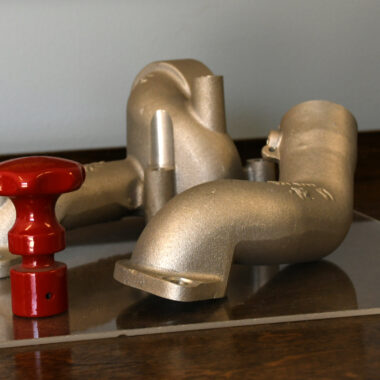The Ultimate Guide to Aluminum Casting: Expert Insights and Ideal Practices
The Ultimate Guide to Aluminum Casting: Expert Insights and Ideal Practices
Blog Article
Checking Out the Various Methods of Light Weight Aluminum Casting: A Comprehensive Guide
Light weight aluminum casting stands as an essential procedure in the development of various items we come across daily, from intricate auto elements to household components. Understanding the varied methods made use of in aluminum spreading is essential for suppliers seeking accuracy and effectiveness in their manufacturing processes - aluminum casting. As we get started on this exploration of the numerous techniques associated with aluminum casting, we reveal a world where advancement and tradition assemble to form the products that form our modern-day world
Sand Spreading Method
Making use of among the oldest and most extensively used techniques in light weight aluminum spreading, the sand casting technique entails creating molds from a combination of sand and a binder material. This method is very functional, affordable, and appropriate for generating a vast array of sizes and shapes, making it a prominent option in numerous industries.

Light weight aluminum, heated up to its melting point, is after that poured right into the mold, loading the tooth cavity. After cooling down and solidifying, the sand mold is escaped, exposing the aluminum spreading. This method enables the production of complicated geometries and is well-suited for both high and low volume manufacturing runs.
Investment Casting Strategy
Having actually explored the sand casting technique, a polished approach to aluminum casting is the financial investment spreading strategy, which offers unique advantages in terms of accuracy and surface area coating. Financial investment casting, also understood as lost-wax casting, is a process that includes developing a wax pattern that is covered with a ceramic covering.
Furthermore, investment casting is recognized for its superb dimensional precision and tight tolerances, making it a recommended approach for creating parts that call for limited specs. In general, the financial investment spreading method is a efficient and versatile method for making premium aluminum parts.
Long-term Mold Refine

One of the crucial advantages of the Long-term Mold And Mildew Process is its capacity to produce components with a finer grain framework, resulting in enhanced mechanical properties. By leveraging the Long-term Mold and mildew Process, makers can achieve cost-efficient production of light weight aluminum components with outstanding dimensional precision and surface area finish.
Die Casting Technique
As opposed to the Permanent Mold And Mildew Refine, the Pass Away Casting Approach for light weight aluminum spreading involves utilizing a recyclable steel mold and mildew to generate elaborate get rid of high dimensional precision. This approach is widely used in different markets due to its capability to successfully manufacture intricate shapes with thin walls and outstanding surface coatings.
Pass away casting usually starts with the prep work of the steel mold and mildew, which is after that splashed with a lubricating substance to facilitate the removal of the solidified aluminum. The mold is closed, and molten aluminum is injected under high stress right into the tooth cavity. When the light weight aluminum solidifies and cools down, the mold and mildew opens up, disclosing the completed component.
Among the crucial benefits of die spreading is its high production rate, making it an economical option for massive production. Furthermore, parts produced through die spreading exhibit exceptional strength and resilience compared to those made through various other casting approaches. This technique is especially suitable for applications requiring detailed layouts, tight resistances, and high repeatability.
Centrifugal Casting Method
Just how can the Centrifugal Casting Method boost the performance and high quality of aluminum spreading processes? Centrifugal casting is an approach that uses centrifugal force to disperse liquified metal right into a mold and mildew cavity. This strategy uses a number of advantages over standard casting approaches.
One key advantage is the premium high quality of the castings created. The centrifugal force aids to get rid of porosity by pressing any type of gas or impurities in the direction of the center of the spreading, resulting in click a denser and extra uniform end product (aluminum casting). In addition, the rotational motion of the mold and mildew guarantees an extra even circulation of the molten steel, leading to enhanced mechanical homes and lowered problems
The method allows for the casting of elaborate shapes and thin-walled parts with simplicity, broadening the style opportunities for makers. In verdict, the Centrifugal Spreading Approach stands out as a trusted strategy for boosting both the performance and top quality of light weight aluminum spreading procedures.

Conclusion
To conclude, the different approaches of aluminum spreading offer one-of-a-kind advantages and features for different applications. Sand spreading offers adaptability and cost-effectiveness, investment casting enables elaborate layouts, permanent mold procedure ensures top notch finishes, die casting gives high production rates, and centrifugal spreading generates high-strength components. Comprehending the distinctions between these techniques can aid manufacturers choose one of the most ideal technique for their particular spreading demands.
Having explored the sand casting technique, a polished strategy to aluminum casting is the investment casting method, which supplies distinctive advantages in terms of precision and surface finish. Investment casting, additionally recognized as lost-wax spreading, is a procedure that involves creating a wax pattern that is coated with a ceramic shell.How can More hints the Centrifugal Casting Technique improve the effectiveness and high quality of light weight aluminum spreading procedures? In final thought, the Centrifugal Spreading Technique view stands out as a trustworthy strategy for boosting both the performance and top quality of light weight aluminum spreading procedures.
Sand casting provides flexibility and cost-effectiveness, investment casting allows for intricate layouts, irreversible mold and mildew procedure makes sure top notch surfaces, die casting provides high production prices, and centrifugal spreading creates high-strength components.
Report this page